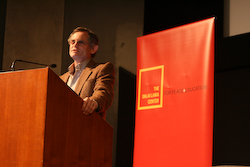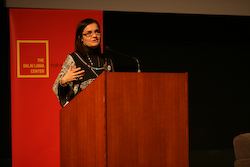Living Compassion in Community
On April 12, in Vancouver’s Downtown Eastside, a neighbourhood with its fair share of challenges, the notion of community was both discussed and on display.
The Dalai Lama Center for Peace and Education welcomed Rev. Ric Matthews of First United Church and Jannet Ann Nordemann of Canadians 4 Compassion for Living Compassion in Community.
Rev. Matthews is uniquely qualified to explore the idea of community, especially within the Downtown Eastside. He has spent the last four years at First United as the Minister of Mission and Community, and has seen just what community can do for each and everyone of us.
What Rev. Matthews was calling for on this evening was the creation of a “sacred space”. A sacred space, according to Rev. Matthews, is a prerequisite for compassion.
 “With what we understand to be compassion, it’s sacred space that makes it real and whole and gives it life. And it makes it life giving,” he said.
“With what we understand to be compassion, it’s sacred space that makes it real and whole and gives it life. And it makes it life giving,” he said.
Rev. Matthews offered three shifts that occur when we find a sacred space. The first is a shift from charity to mutuality.
As Rev. Matthews puts it, it’s a move from “one party caring for another, bringing gifts and resources and blessing, and sharing what one party has with another who is need to a discovery that each is a gift to the other.”
The second shift is from charity to transformation. Rev. Matthews shared the story of his colleague in which she experienced a meaningful transformation when she was able to convince a man to stop taking photographs of a woman who was clearly under the influence of drugs. Her gift to the woman was not charity, but herself. And the woman’s gratitude was a gift in return. Through a compassionate act, they were both transformed.
The final shift Rev. Matthews described is one from charity to justice.
“Justice is not just about the moment, here and now. But it’s the systemic issues behind what’s causing this place,” he said.
Rev. Matthews concluded that while compassion has a warm and fuzzy connotation, the true path should be anything but.
“True compassion, compassion that moves us into a sacred space, isn’t neat and tidy. It’s messy and ugly and scary and vulnerable and awkward. And wonderfully life giving.”
Jannet Ann Nordemann picked up on Rev. Matthews’s idea of a sacred space and took it a step further with her presentation on putting compassion into collective action.
Jannet, too, was calling for a shift. She was calling for a shift from thinking of compassion as some philosophical ideal to really focusing on what compassion means to each and every one of us and how this unites us.
 “We’ve been asking the questions to politicians, presidents of universities, mayors, to people making their living off the street, whether they want to or not, and asking the question, ‘What does compassion mean to you?’”
“We’ve been asking the questions to politicians, presidents of universities, mayors, to people making their living off the street, whether they want to or not, and asking the question, ‘What does compassion mean to you?’”
“The diversity of answers in themselves reflects the diversity of who we are and when we actually enable the discussion of what it means to be compassionate, we create that sacred space,” she said.
Jannet’s work is closely linked with Karen Armstrong’s work with the Charter for Compassion. The Charter is a call for people to embrace a unifying constant of many of the world religions, which is to do unto others as you’d have them do unto you, or the golden rule.
So far, over 70,000 people have affirmed the Charter, but Jannet wants to expand on this by having not just individuals affirm the Charter, but entire communities.
Part of the goal of this project, which has seen London, Ontario become the first Canadian city to affirm the charter, is not just for the individual communities, but also to show the whole country that there is an abundance of compassionate people all around us.
“There is a sense for a lot of people that there is a disparity, a shortage of compassion. But I can share with you that where I go, there’s outstanding and fantastic examples of compassion in action,” she said.
“We just need to enter into a discussion and share with each other what we believe compassion to be.”
To hear the complete video and audio podcasts, click below to play.
You are missing some Flash content that should appear here! Perhaps your browser cannot display it, or maybe it did not initialize correctly.
